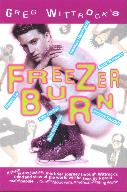

| Graphic by YIKES,Inc. |
by Lorrie Kim

I am halfway to my seat, the house lights still on, audience members still chatting and wandering about, before I realize that the performance has already started. The rink is an aquarium tank; the ice is water. Three sharks all in black, wearing head masks and dorsal fins, drag themselves silently about the ice with their stomachs resting on little trays.
Then enters a bride with three lit candles on her head. The audience applauds. The house lights go down.
Greg Wittrock appears in makeup, no mask, wearing a short pink negligée over black tights, with pink barrettes in his hair. He does an introductory solo, with a nice sideways leaning spin, good turnout on his spins and angles.
White cubes stacked on top of each other into a curved wall form the set, partitioning off the central portion of the SkyRink surface to approximate the shape of a traditional off-Broadway theatre. The burnt-out refrigerator forms part of the wall.
The sharks reappear as doctors; the cubicles are an asylum.
Greg's character crawls into his freezer as they laugh at him. Braids. A small, crying, petulant girl.
The phone rings.
Two businessmen appear, in businessman drag. And look -- there's sweaty Alex Inadequate, in his pink nightie and tie, struggling to keep up.
Oh, dear. A facial masque, curlers, housecoat with cigarette. That cigarette is permanently fused to the mask. It's a good thing this woman is obviously indestructible, or she would have burned to death long ago smoking in bed.
The woman we've all been waiting for. Ah, Whorita, light of my loins. One Whorita. Two Whoritas. Three Whoritas! This is wonderful. It makes you realize for the first time what a trashy song "Love to Love You" really is. This is a real program! Have you ever seen a chair do double three-turns? I guess with Whorita around, even furniture can skate.
Until the ecstasy is shattered by a phone call. Greg takes off his mask. Two ghostly shrouded figures glide in ominously. They must be emissaries from the American Open Ministry of Culture, come to protect the Illinois suburbs from Whorita's pernicious influence....
Oh. A stooped homeless man limps by, his left foot on a flat, his right on a turned-in outside edge. He lifts his head wearily to give a long, mutely expressive, not-quite-mournful searching look at each member of the audience. Slowly.
He passes.
Pep time! Greg comes and addresses the crowd on Ego Empowerment.
One, two, three Ronnie Resentments, all aggressive at the audience. These masks are a great idea. Skaters could compete in them and not worry about fixing their faces. Angelika Krylova could spare herself some energy.
It must be gay pride day! A perky cheerleader with golden braids and pom-poms squeals, "I just love being gay!" She squeals the whole cheer. It rhymes.
The more she squeals, the more forced it all sounds. I've felt the empowering roar of mass gay pride many times over the years. Has this tinny undertone always been there?
Critic Brian Pronger calls it "the gay monster," the nightmare image of the gay man as superhuman pervert, the dread and self-dread that permeates all homophobic discourse about men. And here they are, that very monstrosity personified. Morbid black coats, oversized tongues lolling out, 16"-long penises hanging from their crotches. And they move, too. Luridly, they touch their crotches and then slowly rub their pendulous tongues.
Cut to Greg in a thin shirt, shivering.
A typical move from him: swooping fleetly forward in a deep squat of anxiety, hugging his knees.

The Freezer Burn cast really uses the boards in this performance -- to hide, to have mask changes, as barriers from the audience.
Lots of mask changes. Cleaning women in more scary housecoats. Aerobics bunnies. Greg in a bodysuit like a built, shirtless man. It occurs to the viewer that in making these masks, he must have spent a fortune on fake hair alone. A gaunt junkie. Ninjas with blades on their skates, and stockings over their heads. Greg shirtless for real, sans bodysuit.
Ooooh, majestic. Greg as an Asian prince, all hauteur, carriage, and enviable turnout.
Club girls, in wigs and fringe. Silver wigs and boas. A dominatrix and the many dominated, gagged. Skaters in hunched-over spirals trying to maintain balance -- a new take on the required spiral sequence, ha ha.
Now, a vision of fragility. A young woman of kabuki-like pallor, bloodied mouth, closed eyes, head broken to the side like someone hanged -- her loveliness makes the pity of it starker. Trying to tear off her own skin. And then, taking comfort in her own long black tresses. Followed by more skaters, in black dresses, carrying a contraption like a giant black jellyfish: a black umbrella with holes in it, trailing black streamers to the floor.
The Raven swoops in and flies low, masterpiece black feathered mask fluttering with speed, embodying the cleansing peace of wordless freedom in movement. It's Greg skating in a forward crouch again, but differently this time. Intent, transformed, bringing wholeness.
Two women in dresses do backward somersaults around the performance space.
Two doctors carry the body out of the freezer in a plastic bag, drag it onto the ice and leave it there, discolored with exposure. "I hope there are air holes in that," I think.
It's Greg. He thaws out slowly. A horrendous yellow light effect makes the bag look like it's filling with urine. He writhes in agony. He struggles with the enclosure.
Yes! Use your skates! They slash through the bag. He crawls out slowly, exploring the ice, scraping it with his nails. What is this frigid birthplace? He comes to his feet. He skates around. Tentatively at first, finishing with a two-foot spin, gyrating with loose head, bent knees, arched back, arms flung wide.

Upon first viewing, "Freezer Burn" is all about the masks. Most of the characters wear them, and they are hyper-real, each portraying an expression or a persona that you know deeply well. It takes a moment to ascertain whether they are masks, or just skillful makeup. As with all of Wittrock's fantastical creations, the fantasy pushes so far it creates nervous doubt about what is real.
The show is mixed-media performance art on ice, rather than a skating show. But Wittrock and company make good on their promise to explore what is possible on the medium of ice. The show's skating content sneaks up on you, and lingers.
The ninjas skate with long curving swords attached to their blades, extending them and amplifying their impact. They do a lot of toe pick work, a lot of heel work, heavy audible scraping.
The homeless man's limp is an ice skating limp, on a flat and a turned ankle. One could argue that the man in the mask could peer at the audience just as effectively on stage, in sneakers. But putting it on ice changes it. The reality of this man, even limping as he is, is that the manner of his passing is a glide, through your consciousness.
The lingering truth of "Freezer Burn" is that every persona contains both the thing and its opposite. Nearly all of the characters embody a contradiction: Joy-in-Sadness, Sadness-in-Joy, Beauty-in-Decrepitude, Shame-in-Shamelessness, Dignity-in-Shame. The homeless man shows all his shame, and that covers him in dignity. The pity of suffering is tempered with humility. Few things in this world are so beautiful that you can't see the ugliness in them; and nothing is so ugly that you must look away.

Q: Tell me about the character with the blood coming out of her mouth.
A: The geisha. She's one of my favorites, too. Through the course of the show, there's a little girl that's being played out. And she's like the image of this china doll that is broken. I've never spoken that much about her. She represents all the vulnerability and innocence in that piece. And she has a love-hate relationship with her environment. It's part of her skin. She loves herself, but she can't get out of it. She's the ultimate feminine mask -- I don't know what that means. In Japanese culture, the geishas are trained from a very young age to be the perfect embodiment of a woman, the mask. I see geishas as being very in love with what they do, lots of talent and love and theatre in it, yet there's something very haunting in being on stage all the time, not being able to express who you really are, not even really knowing.
Q: I remember a move in that piece involving her inner forearm, looking very vulnerable.
A: There's a double-jointed thing, with the arm behind her head -- it looks like the arm's broken -- there's a lot of flexibility. I did this stretch one day -- a lot of things with the development of the characters are subconscious. I never skated that piece until that week at rehearsals. Two nights before opening. It was really on intuition.
And the Ice Queen character -- I think of that as John Curry. I saw him perform once, and I thought, oh my God, look at all that pride. I was just fascinated by it. Three minutes, jam-packed with pride. I can be all critical, but it was actually a gift, to see it.
Q: Talk to me about the homeless man.
A: I've had friends come over and put that mask on. It makes us cry. Yes, his right foot is turned in. I have that -- it's just taking my body and exaggerating the qualities, although usually I won't let that happen, it's not good for the foot. The characters, their energy probably resides in one particular body part. The geisha, her arm; the homeless man, his foot; the cheerleader, her chest; Whorita, her pelvis.
Q: Did you like working with a cast?
A: The cast was great. It's not so lonely anymore. They gave a lot and it wasn't easy, rehearsing at 1, 2, 3 in the morning. We're going to start working as a company, keep experimenting and keep working on those pieces. The masks are custom-made for each face -- the amount of work it takes to do it....
Q: What's next for you?
A: Making the show better. It all happened so fast. We got the music on a Monday, and opened up on Thursday. Putting the show on stage -- off-Broadway, or in a warehouse somewhere. I'm looking for producers and people who want to sponsor it. I'm making a video of it, three and a half minutes long. It'll be a great tool for me to give people. There are other shows I want to do, as well.
Inquiries about "Freezer Burn" can be directed to press agent Janet Larson, (212) 877-3121.